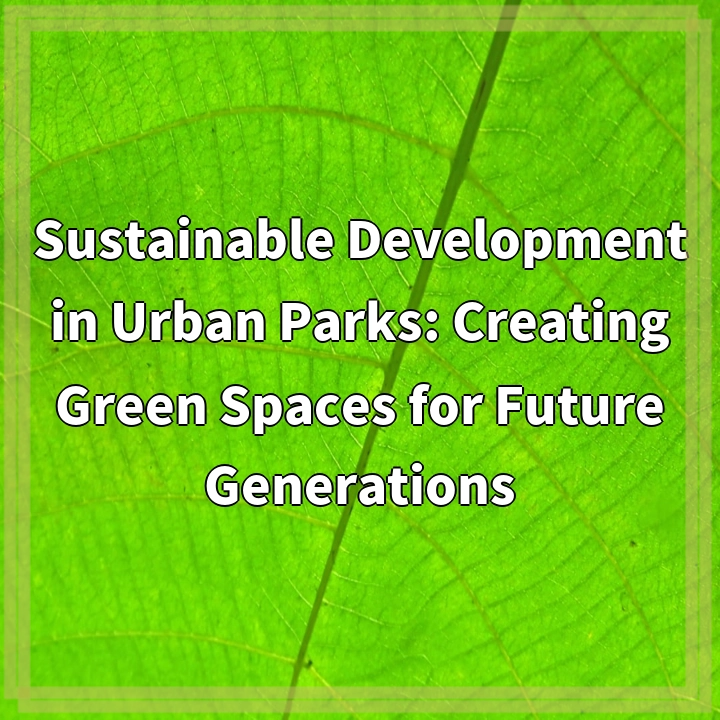
What it is:
Sustainable development in urban parks refers to the approach of designing and managing green spaces in cities to meet the needs of the present without compromising the ability of future generations to enjoy and benefit from these areas. It involves creating parks that not only provide recreational opportunities and enhance biodiversity but also contribute to ecological resilience, social equity, and economic vitality. Sustainable urban parks integrate natural elements with human activities, promoting environmental stewardship and community well-being.
Key Features of Sustainable Urban Parks
Sustainable urban parks are characterized by several key features:
- Green Infrastructure: Incorporating features such as rain gardens, permeable pavements, and urban forests to manage stormwater, reduce heat islands, and enhance biodiversity.
- Community Engagement: Involving local residents in the planning and management process to ensure that the parks reflect the needs and desires of the community.
- Access and Equity: Ensuring that parks are accessible to all community members, regardless of socioeconomic status, age, or physical ability.
- Sustainability Practices: Implementing practices such as native planting, organic maintenance, and the use of renewable resources to minimize environmental impact.
Real-world Problems
Despite the vision for sustainable urban parks, several real-world challenges hinder their development and effectiveness:
1. Limited Space and Funding
Many urban areas face space constraints and budget limitations, making it difficult to create and maintain new parks. Existing sites may be repurposed for development, reducing the number of green spaces available for public use.
2. Socioeconomic Disparities
In many cities, access to parks is disproportionately available to wealthier neighborhoods, leaving underserved communities without adequate green spaces. This inequality can exacerbate health disparities and limit recreational opportunities for lower-income populations.
3. Environmental Challenges
Urban areas often contend with issues like pollution, invasive species, and climate change impacts, which can compromise the health and functionality of park ecosystems. Addressing these challenges requires innovative management strategies and ongoing investment.
4. Engagement and Maintenance
Maintaining sustainable practices in urban parks requires continuous community engagement and resources. A lack of public interest or support can lead to neglect, reducing the parks’ effectiveness and value to the community.
5. Regulatory Barriers
Zoning laws and regulations can pose obstacles to sustainable park development, limiting the ability of city planners and ecologists to implement innovative solutions that are necessary for long-term sustainability.

Solutions for Sustainable Development in Urban Parks
Addressing the challenges associated with sustainable development in urban parks requires a multifaceted approach. Here are some key solutions that can help cities create green spaces that benefit both the environment and the community.
1. Innovative Funding Strategies
To overcome budget constraints, cities can explore diverse funding options such as public-private partnerships, grants, crowdfunding, and engaging local businesses to sponsor park amenities. Additionally, implementing sustainable practices can lead to long-term cost savings through reduced maintenance and energy use.
2. Equitable Park Distribution
Cities must prioritize equitable access when planning new parks. Conducting community needs assessments can help identify underserved areas, ensuring that green spaces are developed where they are needed the most. Engaging local residents in the design process fosters a sense of ownership and promotes inclusivity.
3. Environmental Stewardship Programs
Implementing programs aimed at environmental education and stewardship can empower communities to actively participate in the conservation and maintenance of urban parks. Initiatives such as volunteer planting days, clean-up events, and educational workshops can promote sustainable practices and foster a sense of community responsibility.
4. Adaptive Management Practices
Utilizing adaptive management practices can help cities respond effectively to environmental changes and challenges. This approach encourages regular monitoring of park ecosystems, allowing for timely adjustments to management strategies based on observed outcomes and community feedback.
5. Policy Reform and Collaboration
Advocating for policy reforms that support sustainable urban park development can help dismantle regulatory barriers. Collaborative efforts among city planners, environmental organizations, and community groups can lead to innovative solutions that align with sustainability goals while benefitting urban residents.















